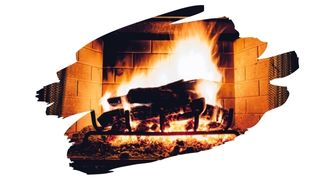Using good clean burning firewood in your fireplace, is one thing. But, not all types of wood will produce enough heat to truly warm up your home. And you can’t really tell on the face of it, how much heat firewood can create.
So, what are some of the things you need to look for when it comes to choosing firewood? And does Willow wood meet those criteria?
Well, in this post, you’ll learn what you need to look for when it comes to choosing clean burning firewood. You’ll also learn how Willow compares against other more popular firewood choices.
And keep reading to find out exactly how much heat you can expect to generate out of a cord of Willow wood.

This post may contain affiliate links to products that we receive a commission for (at no additional cost to you). Learn more here.
What Type Of Wood Generally Burns The Cleanest?
Ideally, firewood should be dry, it should not contain much sap, and it should not come from a poisonous tree. What’s more, if you want it to heat your home, (rather than merely act as kindling), then it should also be fairly dense to boot.
You see, tough dense hardwoods generate more energy (i.e. heat in this instance) as they burn. And this is why hardwoods like White Oak and Birch are famously used for firewood, right across North America.
Related Post: Is Acacia Wood A Good Choice For Firewood?
What About Smoke? What Kind Of Firewood Produces Very Little Smoke?
If that firewood log is still damp, it’ll produce a lot of thick smoke. That’s because, as the moisture in firewood evaporates, it creates all of that excess smoke to release into the air.
This is why you need to season wood before you use it in your fireplace. Seasoned wood is simply freshly logged wood that has been allowed to dry out for months. This will reduce the amount of moisture, (i.e. it’s Moisture Content), in that firewood.
Otherwise, if you try to burn damp wood, expect a significant amount of smoke. That’s why you should properly season wood before burning it as fuel.
You can learn more about seasoning wood by checking out our post here: How To Season Wood (7 Tips)
What Does Moisture Content Mean (As It Relates To Firewood)? It merely references the amount of water contained in a specific piece of material. Newly cut wood, (also referred to as green wood), has a moisture content of one hundred percent. While seasoned wood — that has had six to twelve months to dry — has a moisture content of less than twenty percent.
And What Kind Of Wood Should Not Be Burned In A Fireplace?
Certain trees that are considered poisonous, such as the Yew Tree, aren’t good firewood choices. Avoid burning them since those trees contain compounds that are toxic.
As these poisonous woods burn, their toxins can vaporize and fill your home with harmful fumes.
You should also steer clear of burning any wood that’s filled with tree sap/patch. Wood types such as Cedar and Pine, contain so much sap that they can gum up the soot in your chimney flue.
This poses a fire risk, as a blocked chimney flue can directly cause chimney fires.
Related Post: Is Mimosa Tree Timber A Good Choice For Firewood?
Okay, But What About Willow Wood? Is It Good For Firewood?
Well, when it comes to heat and density, Willow wood isn’t a great option for your fireplace.
Willow tree lumber isn’t very dense. According to its Janka rating, (which measures the hardness of wood), this tree is over 50% less dense than Oak.
Willow has a Janka rating of 570 lbf, which means it takes 570 pounds of force to crack this timber. While White Oak has a Janka rating of 1350 lbf.
Now, low density wood means that it doesn’t take much energy for fire to burn through that Willow wood. And the less energy it takes to burn, the less heat it produces.
And this is reflected in Willow woods BTU (British Thermal Unit). The BTU rating of a piece of wood measures how much heat energy is released when a piece of firewood is burned.
The greater the amount of energy (BTU), the hotter the fire will be.
White Oak has a 25.7 BTU rating, while Birch wood has a 23.6 BTU rating. Willow wood, on the other hand, has a mere 17.6 BTU rating per cord. And this makes Willow wood pale in comparison to those other two timbers.
Related Post: Is Birch Wood Good For Smoking Meat?
What About Safety? Can I At Least Burn Willow Wood For Kindling?
Willow trees aren’t toxic. In fact, the bark of this tree has medicinal qualities to it. Nonetheless, Willow wood isn’t safe in your fireplace for another reason.
And what is that? Well, it all boils down to it’s tree sap. Willow trees have a tree sap that is very watery. It saturates the bark of this tree.
Now, Willow tree sap isn’t as thick and congealed as that of other sap-saturated softwoods. Regardless, between it’s sap, low BTU, and low density, Willow wood is simply unsuitable for an indoor fireplace.
To Wrap Up, Here Are The 3 Key Takeaways From This Post…
- 1). Good firewood should be dry, dense, and free of tree sap or pitch.
- 2). Willow wood is a low density sap-saturated softwood. This makes it a poor choice for firewood.
- 3). Also, compared to better firewood options in the form of Oak and Birch, Willow does not produce much heat either.
References:
Wood Smoke Awareness | EPA.gov
British Thermal Unit | Wikipedia.org



